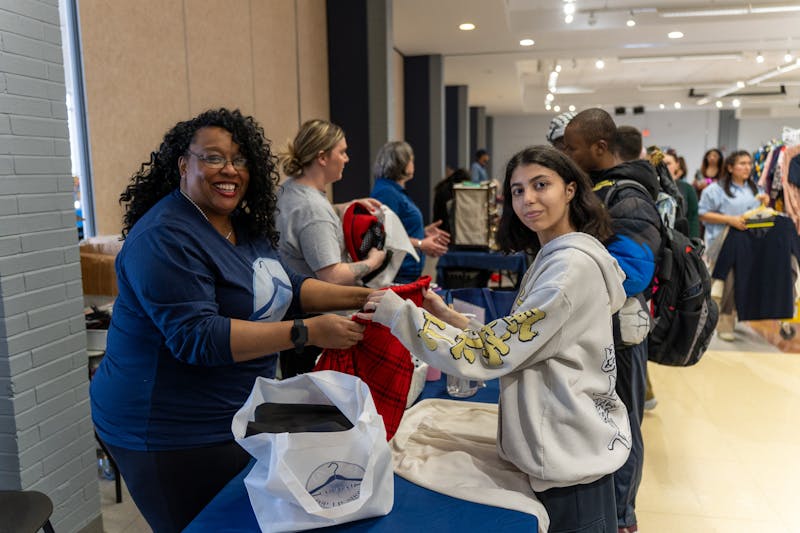The Lunar New Year begins on Saturday, January 28, 2017 and Kean University celebrates with Student Organization (the full-time undergraduate student government), Graduate and Part-Time Student Council (GPSC), throwing a Lunar New Year celebration in the Miron Student Center Alumni Atrium (MSC) during 3:30 p.m. to 4:30 p.m.
This year is the year of the fire rooster, who is said to be known for being trustworthy, punctual and responsible. Each table in the MSC was decorated with red envelopes, which represented wealth, and also oranges and tangerines, which represented wealth and luck. The area was heavily decorated with red decor and furnishing, representing good luck, fortune, happiness and joy.
Before the main performance of the festival, many tables were set up by the Center of International Studies (CIS), Wenzhou-Kean University Student Association (WKUSA) and Student Organization promoting and sharing information regarding studying abroad and Asian Studies and culture. Each student was encouraged to check out the tables and take part in each activity presented at the table to enjoy part of the festival.
Wenhui Zhang, junior global business major, is an international student who is part of WKUSA. He has enjoyed many of the events hosted at Kean University and was happy to help out at this cultural event.
"I like this experience because I can help WKUSA with writing the zodiac characters, there is good food provided and I look forward to the awesome show," Zhang said. "It's good and awesome that Kean [University] does this kind of festival. It makes me feel very involved."
When entering the MSC, students were asked to give their student I.D. or number to the Student Organization table for a raffle ticket. The raffle ticket was the only way students were able to obtain a milk tea bubble tea or a green tea bubble tea.
Following, Student Organization set up a place for students to have their picture taken by a polaroid with their friends. There were little props such as dragons and banners to add to the picture.
After, there was a table hosted by WKUSA where one could find out how to say their Chinese zodiac in Mandarin and paint the written character with ink and a paint brush. The next table provided information about the Asian Studies program at Kean University and gave students and children the chance to color in a festive mask for themselves. There was a separate table that gave people the choice to have their name written in Chinese calligraphy on rice paper and learn how to say their name in Mandarin.
The CIS table gave plenty of information and insight on travelling and studying abroad, as well as promoting the student organization International Student Association (ISA). If one wanted to join ISA or go to the Study Abroad Fair, they could grab a flyer and sign up for the next study abroad workshop.
The last table had plenty of Korean, Chinese, Taiwanese and Vietnamese snacks and drinks, which was only accessible after the dragon dance performance. There was bubble tea, mango juice, soy milk, rice crackers, dried fruit snacks, Chinese gummies, festival snacks, sunflower seeds and sesame seed cookies.
After some time, drums started beating, cymbals started crashing and the professional performers were ready. At first, the dragon came out, representing China and its luck. It is commonly known that the longer the dragon, the more luck it will bring to those around. Not only does the dragon represent imperial authority, but it also represents power, wisdom and strength.
Soon after, the lion came out and greeted the audience who were watching. As it blinks and flashes its eyes at everyone, it means the lion has been brought to life. The lion has been considered prosperous and a sign of success, so it will dance around and chase vegetables with a stick and red envelope attached to it. During the performance, someone from the audience was offered to feed the lion with the long stick, to which the lion spit out the vegetables but kept the red envelope, which meant that it only kept the money for good fortune.
The lion and dragon dance are traditional performances for Lunar New Year and they are usually performed during Chinese festivals. Although it is practiced in other Asian countries, it is widely and heavily known to be a Chinese custom.
After the performance, students were free to line up for the snacks and drinks, as well as continue on with the other activities provided by Student Organization. Chinese music began playing and food, such as chicken, rice, dumplings and spring rolls were brought out for students to try.
William Harrison, senior Asian Studies major and computer science minor, has helped out with the Asian Studies Department and WKUSA. He also traveled abroad last semester to the Kean University located at Wenzhou.
"I enjoyed this festival because I helped WKUSA with a piece of their home. The lion dance and the dragon dance--they were both great and my favorite thing out of this whole festival. Speaking of which, I do encourage travelling abroad, because it is something everyone should experience...it really changes your perspective on cultures," Harrison explains. "I think it's great that Kean [University] does these events because even after a short time, it brings people together."
At about 5 p.m., most of the Lunar New Year festival was finished and faculty, students and visitors headed to class or back home. Many students enjoyed the annual Lunar New Year festival held at Kean University and looked forward to experiencing another culture for a moment.






